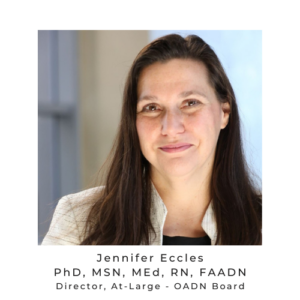June 24, 2024
 Dear OADN Members:
Dear OADN Members:
The math is simple: the United States has over 1100 associate degree nursing education programs. In 2023, these made up 44.7% (83,387) of new nursing graduates in the United States (National Council of State Boards of Nursing, 2024). Furthermore, 40% of these nurses go on to higher levels of education (Smiley, et al., 2023), including baccalaureate programs and beyond, to nurse anesthetists, nurse educators, nurse midwives, and nurse scientists, to name a few.
Associate degree nursing graduates are vital to supplying and maintaining the nursing workforce in our country. ADN education programs provide a more rapid influx of qualified nurses to mitigate staffing shortages, attract a diverse population to contribute to a more equitable healthcare system, and educate residents who tend to stay in their local areas, especially rural areas. But you know this! Or you wouldn’t already be part of OADN.
So please allow me to highlight something our country needs from you besides all the wonderful things you’re currently doing:
WE NEED MORE NURSES FROM ASSOCIATE DEGREE NURSING EDUCATION PROGRAMS!
We’re in a nursing shortage! The U.S. Bureau of Labor Statistics projects that the employment of registered nurses will grow significantly, with an estimated need for 193,100 new RNs each year through 2032 to fill new positions and replace retiring nurses (Bureau of Labor Statistics, U.S. Department of Labor, 2024). In 2023, there were only 186,350 RN Candidates to take the NLCEX® across the US (National Council of State Boards of Nursing, 2024). That means that if ALL these graduates became RNs, we would still be short by 6,750 nurses to meet the 2023 demand, let alone the pent-up demand from not meeting these needs in previous years, which would cause this number to grow exponentially.
ADN programs are essential in meeting this growing demand. The country needs YOU to do something. Ask yourself:
These are all hard questions. We know that many ADN programs need more faculty and competitive pay for faculty. Your programs often lack enough clinical space, enough simulation expertise, and enough student support budget dollars. ADN programs are less researched than BSN and above education programs. Students often need more funds and support to focus on their education full-time. And this is EXACTLY why we have OADN.
OADN brings people from ADN programs together to solve these big problems. OADN is your voice nationwide to help our federal and state governments understand what ADN programs need. OADN brings ADN experts like you to the table to gather best practices and disseminate them nationwide. OADN supports new ADN program leaders and promotes the value of ADN nursing education. The annual convention brings ADN educators and leaders together to learn about innovations happening in practice around the nation.
That being said, OADN is all of you. Please consider joining OADN committees, attending the convention, presenting at a future convention, and implementing some of the innovations OADN highlights. OADN will benefit you, and the nation needs your expertise.
Jennifer Eccles PhD, MSN, MEd, RN, FAADN
Director, At-Large, OADN Board of Directors
BIBLIOGRAPHY
Bureau of Labor Statistics, U.S. Department of Labor. (2024, April 17). Registered Nurses. Retrieved May 29, 2024, from Occupational Outlook Handbook: https://www.bls.gov/ooh/healthcare/registered-nurses.htm#tab-6
National Council of State Boards of Nursing. (2024). NCLEX Statistics from NCSBN: 2023. Retrieved from https://www.ncsbn.org/publications/2023_NCLEX_Pass_Rates
Smiley, R. A., Allgeyer, R. L., Shobo, Y., Lyons, K. C., Letourneau, R., Zhong, E., . . . Alexander, M. (2023, April). The 2022 National Nursing Workforce Survey. Journal of Nursing Regulation, 14(1, Supplement 2), S1-S90. doi:https://doi.org/10.1016/S2155-8256(23)00047-9